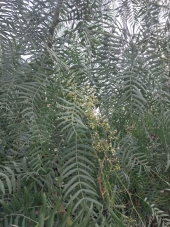





Barbara Simoes wrote:I didn't mean to make it sound like it's coming in in droves; it's not, but let's just say, I'm vigilant and am always patrolling and on the lookout for invaders. I have blackberries from a neighbor's place that the birds love planting here, sumac that sprouts up to six feet before I see it from the same neighbor....My best advice would be to plant some well-behaved impenetrable perennial on the outside borders. My personal favorite is hosta but I know some people who love comfrey. I like the hosta because the root becomes a solid mass, it's easy to divide: one plant can become ten very soon, it's well-behaved in that it doesn't run or spread horribly, it's a good height for a border, it's got sweet flowers that the bees love and it's easy enough to dig out as proven by the number of times I do that to divide plants.
I really think that you could save yourself money and not have to bother with the landscaping cloth, especially if you plan to put wood chips over them--the wood chips will start to break down and create "soil" which is all it takes for something to grow there. The roots will puncture through the cloth and then every year you will be weeding the holes made--ask me how I know! If you use landscaping cloth, you want to keep the top surface clean. If there is a bit of dirt or soil, seeds and roots will find it. I used it both in my vegetable garden and where I have my blueberries. I used to weed and leave the weeds on top of the landscaping cloth. Of course, they would start to break down, create soil, and the next thing I knew, I had crabgrass and all sorts of "lovelies" growing there. My advice would be to either go with just cardboard with chips, or landscaping cloth, but not both unless everything is under the cloth.

Barbara Simoes wrote:Yes, it will come through. It will travel great distances, too. One of my gardens is bordered by a town sidewalk and the perpendicular side by driveway, yet Bermuda grass jumped or came in from beneath the sidewalk...yikes!

Anne Miller wrote:To me as long as the Bermuda cannot see light though it is possible for it to spread under that and come up on the other side.
I like to recommend cardboard and wood chips for 6 inches to 12 inches because ... how much light can get through that? And those will biodegrade.
This thread seems to indicate that some plants can punch through landscape fabric, I don't know as I have never used it:
https://permies.com/t/114968/Plants-punch-landscape-fabric
I love Bermuda and have never had a problem with my raised beds.



Christopher Weeks wrote:This was my grandma's house from 1954 until 2019 when she passed away. I think it's the same kind of tree you're talking about. I have very fond memories of climbing in it especially in 1979.
